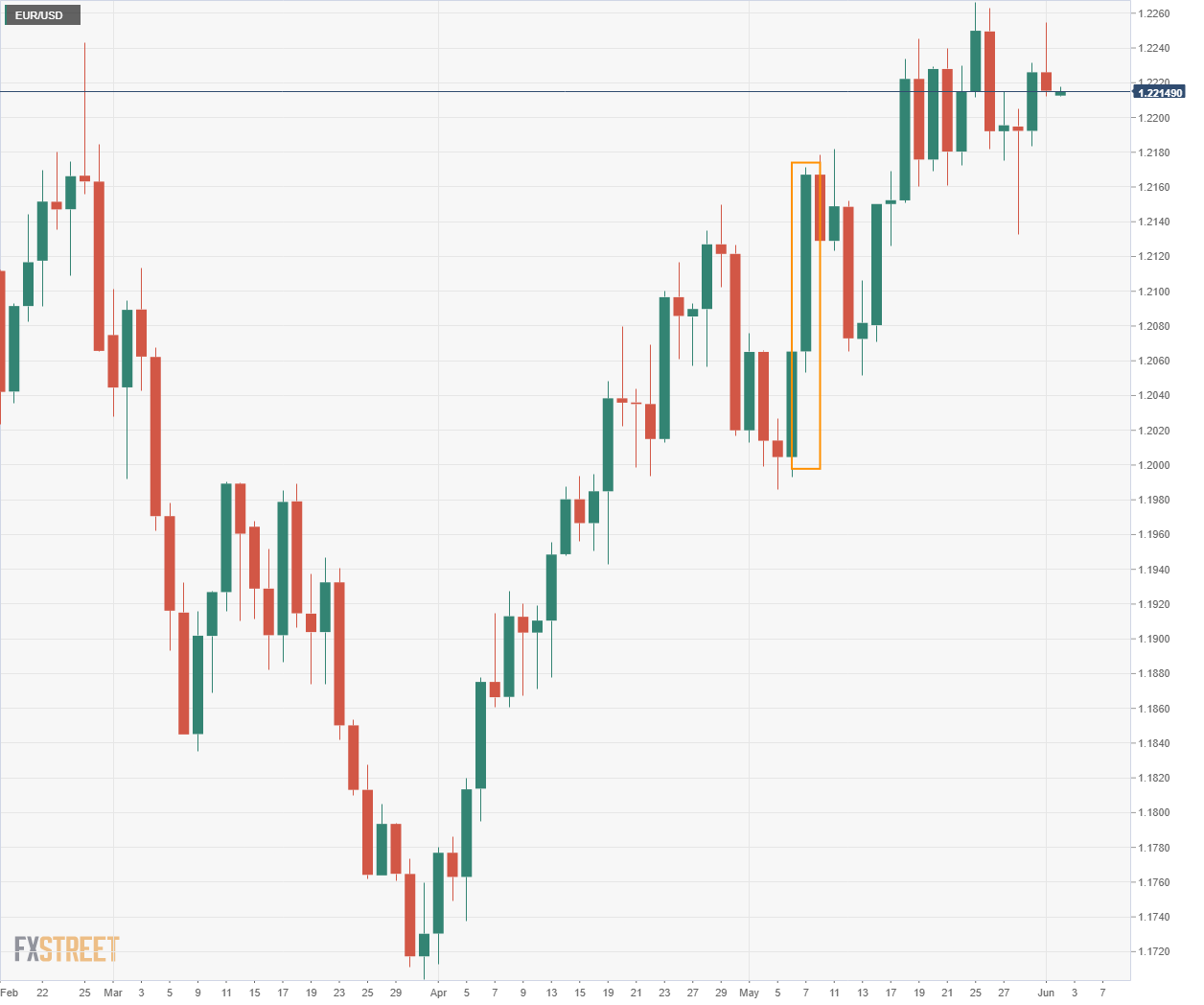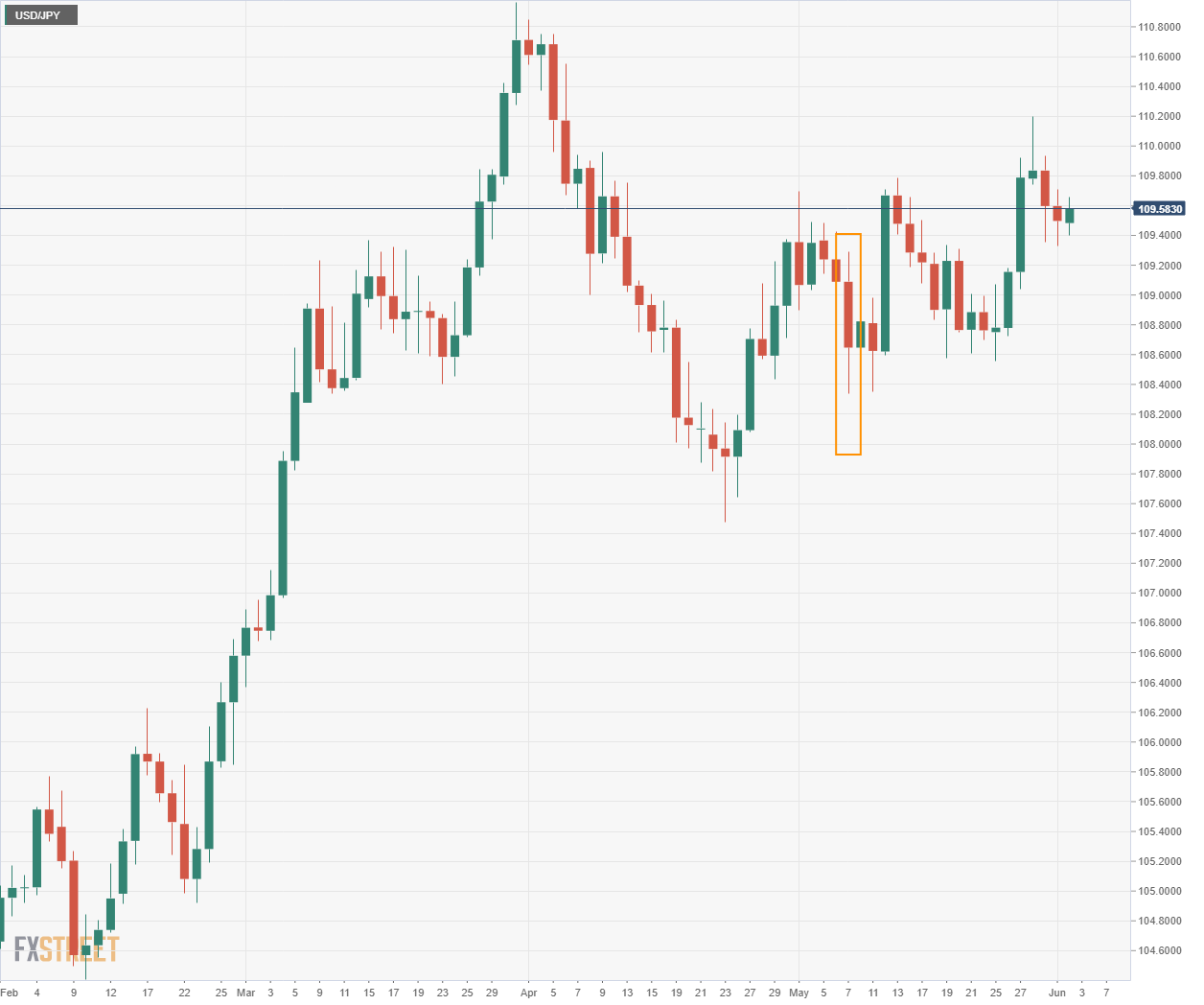- ADP payroll clients expected to add 650,000 positions in May after 742,000 in April.
- Nonfarm Payrolls were a major disappointment in April at 266,000.
- Markets keyed on Friday’s May NFP report, forecast at 664,000.
- Manufacturing Employment was weak for the second month in May.
Until a month ago the US labor market was thought to be in a headlong rush to make good the lockdown job losses of last year.
March’s 916,000 new jobs were expected to be duplicated in April, giving the US economy the best two months of job creation since the third quarter of 2020.
ADP and NFP in April
Then, on May 7 Nonfarm Payrolls recorded just 266,000 new hires in April, barely one-quarter of the 978,000 forecast. The March total was revised down 146,000 to 770,000.
The miss and reduction were entirely unheralded.
Nonfarm Payrolls
Private payrolls from Automatic Data Processing (ADP) for April, released two days earlier, had added 742,000 new positions. While this was a minor miss of the 800,000 estimate, it was the best month since September 2020, seconded the Employment Purchasing Managers Indexes (PMI) from the Institute for Supply Management (ISM) and seemed to indicate that NFP would equal or surpass its prediction. The ADP total for March, unlike NFP, was adjusted higher to 565,000 from 517,000.
ADP Payrolls
Market reaction
Markets have responded to the dismal April payroll number with skepticism.
In the month since, the dollar has lost ground against the euro, sterling and Canada but gained versus the yen. Equites and Treasury rates are little changed from their positions at the close on May 7.
The verdict has been to wait a month to find out if the April result was an anomaly.
Perhaps, the dismal number was a product of the Bureau of Labor Statistics (BLS) seasonal adjustment gone awry. The unadjusted April payroll was 1.089 million.
Maybe, the recently enacted supplement and extension to federal unemployment insurance had encouraged workers to take another month or two of government funded sabbatical.
With 8.1 million unfilled positions in the March Job Openings and Labor Turnover Survey (JOLTS), likely more in April and May, and employers offering higher wages, the lack of hiring appeared inexplicable.
ADP
The client list of ADP is again under the market scrutiny for what it predicts of the national payroll figures from the BLS.
Private payrolls administered by ADP are expected to rise 650,000 in May.
Even though the monthly correlation of the two numbers is not reliable, as was proven last month, the two are still considered close statistical cousins.
April Employment PMI
The April Manufacturing Purchasing Managers’ Index had given a mild warning that the inability to find workers was creating serious problems for many firms.
Manufacturing Employment PMI
FXStreet
Employment PMI dropped to 55.1 from 59.6, missing the 61.5 forecast by a wide margin.
In the general expectation that an excellent NFP report was pending, the retreat was ignored, 55.1 was still a respectable expansion.
The services employment PMI, giving April conditions in the much larger sector belied the weaker manufacturing post. It rose to 58.8 from 57.2, surpassing its consensus forecast of 55.
The two April PMI reports, combined with ADP’s payrolls did not seem to indicate any dramatic problems in the US labor market.
May Employment PMI
Manufacturing managers have given a much more forceful warning in May that hiring is lagging. Employment PMI dropped to 50.9 from 55.1, just skirting the 50 dividing line between expansion and contraction. It had been forecast to rise to 61.5. The more than 10 point discrepancy between prediction and result is rare.
The Institute for Supply Management releases its service sector indexes on Thursday. Employment PMI is expected to slip to 58 in May from 58.8 prior. Given the weakness in the manufacturing index, the risk for this index is lower.
Services Employment PMI
FXStreet
Conclusion
Except for the minor signal from the April manufacturing employment index that all might not be well, there were no indications that the payroll report would be a debacle.
That is not the case for May.
The Manufacturing Employment PMI at 50.9 has lost 8.7 points in two months. It will not matter for payrolls if the problems reported by managers are lack of workers rather than lack of jobs. The impact on hiring will be the same, far fewer workers resuming employment.
In the current context ADP’s payroll numbers for May are a one-way street.
If they meet or exceed expectations, markets will remember that they nearly did so in April, predicting nothing of the NFP failure.
If they are worse than the 650,000 prediction, they will reinforce the poor performance of the May manufacturing employment index.
Equity, credit and currency markets are very sensitive to any signals that the US labor market is faltering.
A poor ADP report could send equities, Treasury yields and dollar into retreat.
Information on these pages contains forward-looking statements that involve risks and uncertainties. Markets and instruments profiled on this page are for informational purposes only and should not in any way come across as a recommendation to buy or sell in these assets. You should do your own thorough research before making any investment decisions. FXStreet does not in any way guarantee that this information is free from mistakes, errors, or material misstatements. It also does not guarantee that this information is of a timely nature. Investing in Open Markets involves a great deal of risk, including the loss of all or a portion of your investment, as well as emotional distress. All risks, losses and costs associated with investing, including total loss of principal, are your responsibility. The views and opinions expressed in this article are those of the authors and do not necessarily reflect the official policy or position of FXStreet nor its advertisers. The author will not be held responsible for information that is found at the end of links posted on this page.
If not otherwise explicitly mentioned in the body of the article, at the time of writing, the author has no position in any stock mentioned in this article and no business relationship with any company mentioned. The author has not received compensation for writing this article, other than from FXStreet.
FXStreet and the author do not provide personalized recommendations. The author makes no representations as to the accuracy, completeness, or suitability of this information. FXStreet and the author will not be liable for any errors, omissions or any losses, injuries or damages arising from this information and its display or use. Errors and omissions excepted.
The author and FXStreet are not registered investment advisors and nothing in this article is intended to be investment advice.
Recommended Content
Editors’ Picks

EUR/USD treads water just above 1.0400 post-US data
Another sign of the good health of the US economy came in response to firm flash US Manufacturing and Services PMIs, which in turn reinforced further the already strong performance of the US Dollar, relegating EUR/USD to the 1.0400 neighbourhood on Friday.

GBP/USD remains depressed near 1.2520 on stronger Dollar
Poor results from the UK docket kept the British pound on the back foot on Thursday, hovering around the low-1.2500s in a context of generalized weakness in the risk-linked galaxy vs. another outstanding day in the Greenback.

Gold keeps the bid bias unchanged near $2,700
Persistent safe haven demand continues to prop up the march north in Gold prices so far on Friday, hitting new two-week tops past the key $2,700 mark per troy ounce despite extra strength in the Greenback and mixed US yields.

Geopolitics back on the radar
Rising tensions between Russia and Ukraine caused renewed unease in the markets this week. Putin signed an amendment to Russian nuclear doctrine, which allows Russia to use nuclear weapons for retaliating against strikes carried out with conventional weapons.

Eurozone PMI sounds the alarm about growth once more
The composite PMI dropped from 50 to 48.1, once more stressing growth concerns for the eurozone. Hard data has actually come in better than expected recently – so ahead of the December meeting, the ECB has to figure out whether this is the PMI crying wolf or whether it should take this signal seriously. We think it’s the latter.

Best Forex Brokers with Low Spreads
VERIFIED Low spreads are crucial for reducing trading costs. Explore top Forex brokers offering competitive spreads and high leverage. Compare options for EUR/USD, GBP/USD, USD/JPY, and Gold.





